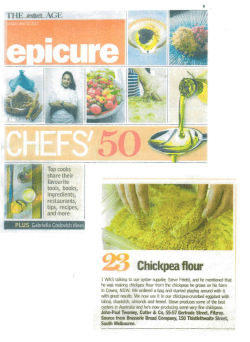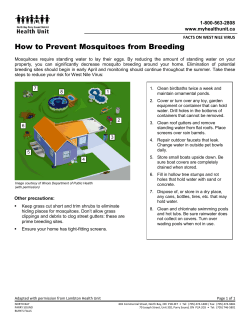
Document
RESEARCH Chickpea translational genomics in the ‘whole genome’ era by Manish ROORKIWAL1, Mahendar THUDI1, Pooran GAUR1, Hari D. UPADHYAYA1, Narendra P. SINGH2 and Rajeev K. VARSHNEY1,3* Abstract: Chickpea (Cicer arietinum) plays vital role in ensuring the nutritional food security in Asian and sub-Saharan African regions of the world. Conventional breeding efforts to elevate the yield levels and enhance crop productivity are constrained due to low level of genetic diversity present in the cultivated gene pools. Large scale genomic resources in chickpea have enabled the use of molecular breeding to develop superior chickpea varieties. In addition, efforts with an objective to exploit the available huge genetic diversity in genebank to address the issue of low productivity, ICRISAT has initiated large scale genome re-sequencing projects. Key words: chickpea, genome resequencing, molecular breeding Introduction Chickpea (Cicer arietinum L.), the second largest cultivated grain food legume in the world, is highly nutritious and protein rich source which contributes to income generation and improved livelihood of smallholder farmers in sub-Saharan Africa and Asia. During 2012-2013, the area, production and productivity of chickpea were 13.5 million ha, 13.1 million tones and 967 kg ha-1, respectively (1). _________________________________________________________________________________________________________ 1International Crops Research Institute for the Semi-Arid Tropics (ICRISAT), Hyderabad, India (r.k.varshney@cgiar.org) 2Indian Institute of Pulses Research (IIPR), Indian Council of Agricultural Research (ICAR), Kanpur, India 3School of Plant Biology and the Institute of Agriculture, The University of Western Australia (UWA), Crawley, Australia Despite the efforts to increase the chickpea productivity, several abiotic (drought, heat, salinity) and biotic (fusarium wilt (FW), ascochyta blight (AB), botrytis grey mould, dry root rot, pod borer) stresses coupled with recent changes in climate have hindered the yield improvement (6). In order to fill the yield gap, there is a need to enhance precision and efficiency of selections in the segregating generations for higher and rapid genetic gains and to meet the current food and nutritional requirements. Recent advances in genomics, especially in the area of next generation sequencing (NGS) and genotyping technologies, have reduced the cost of sequencing drastically enabling large scale genome re-sequencing to understand the genetic architecture. As a part of several global initiatives and strategic collaborations with NARS partners, large scale genomic resources including molecular markers, comprehensive genetic maps including physical map, trait mapping, and transcriptomic resources have been developed (12). In the case of chickpea, large scale molecular markers including simple sequence repeats (SSRs), hybridization-based Diversity Array Technology (DArT) and sequence based markers such as single nucleotide polymorphisms (SNPs) have become available. Use of a particular marker system for genetics research and breeding application depends on the throughput and cost of the marker assays. In order to use these markers, cost effective genotyping platforms including KASPar (2) and BeadXpress (4) system were developed. These large scale genomic resources have enabled the development of superior chickpea varieties that can sustain the yield when exposed to stress environments. Legume Perspectives 7 Molecular breeding product Advances in chickpea genomics research have made it possible to utilize genomics for enhancing the precision and efficiency. In order to use markers associated with trait of interest indentified using linkage mapping and genome-wide association studies, marker assisted backcrossing (MABC) was used to introgress the QTL/genomic region in the elite chickpea cultivars JG11. MABC has been successfully used to introgress the “QTL-hotspot” that harbors QTLs for drought tolerance-related traits. Introgression lines has shown improved performance with increased yield as compare to recurrent parent in rainfed as well as irrigated conditions (9). Similarly, two parallel MABC programmes were undertaken at ICRISATfor introgression of FW and AB resistance by targeting foc1 locus and two quantitative trait loci (QTL) regions, ABQTL-I and ABQTL-II in C 214, an elite cultivar of chickpea. Screening of introgression lines for diseases identified FW and AB resistant lines (10). Efforts to pyramid the FW and AB resistance are underway. Recently, advancement in nextgeneration sequencing (NGS) technologies (8) have enabled the use of genome-wide marker profile/allele data for prediction of phenotype of progenies for selection to the new cycle in breeding programs using genomic selection (GS), a modern breeding approach. Efforts to deploy GS in chickpea have been initiated using training population of elite breeding lines (5). Issue 7 • April 2015 RESEARCH Figure 1. An effort to show linking genome sequence diversity with trait phenotype diversity through “The 3000 chickpea genome sequencing initiative” Connecting phenotype to gene(s) The genome sequence provides the basis for a wide range of studies, from the important goal of accelerated breeding to identifying the molecular basis of key agronomic traits, in addition to understanding the basic legume biology. International Chickpea Genome Sequencing Consortium (ICGSC) completed high-quality draft genome sequence of chickpea (11). In parallel, genome sequence also became available for desi type (3). Draft genome alone, however, cannot address the issue of genetic diversity, therefore efforts to resequence the 300 chickpea lines from chickpea reference set were sequenced at 5X to 13X coverage (Fig 1). Alignment of resequence data on the reference genome has identified > 4 million SNPs that are being used for GWAS along with multi-season phenotyping data. Large scale germplasm resources are available in different genebanks that can be used to explore the available genetic diversity to address the issue of low productivity and bottlenecks’ associated with narrowgenetic Legume Legume Perspectives Perspectives 9 8 diversity. In order to utilize these hugegermplasm collection, ICRISAT has initiated efforts to valorize the global composite collection of chickpea comprising 3000 lines selected from genebanks of ICRISAT and ICARDA (7) for identification of novel alleles. In view of above, ICRISAT launched “The 3000 Chickpea Genome Sequencing Initiative” in 2014. So far ICRISAT has re-sequenced more than 500 chickpea lines (reference set, elite varieties and parents of several mapping populations) at minimum 5X coverage. Issue Issue 71 •• April January 2015 2013 RESEARCH References Summary It is evident that recent advances in genomics, especially in the area of sequencing and genotyping technologies, have revolutionized chickpea genomics in the past decade. Few years back, chickpea used to be known as orphan crop as very limited genomic resources were available. As a part of several initiatives and strategic collaborations with several partners from different countries, large-scale genomic resources including draft genome sequence, comprehensive transcriptome assembly, high density genetic and BIN maps, QTL maps as well as physical maps have been developed. During the past decade chickpea has been transformed from genomic resources poor crop to genomic resources rich crop. These large scale genomic resources have opened the era of translational genomics in chickpea to understand the genetics of traits and as a result, approaches like MABC, and GS are being used in these crops (12).Improved lines have been developed for drought tolerance and resistance to FW and AB. Considering the revolution in chickpea genomics, it is anticipated that coming years will witness more integration of molecular breeding tools and approaches in chickpea breeding programs. (1) FAOSTAT (2013) Chickpea. FAOSTAT. Food and Agriculture Organization of the United Nations, Rome, faostat3.fao.org (2) Hiremath PJ, Kumar A, Penmetsa RV, Farmer A, Schlueter JA, Chamarthi SK, Whaley AM, Carrasquilla-Garcia N, Gaur PM, Upadhyaya HD, KaviKishor PB, Shah TM, Cook DR, Varshney RK (2012) Large-scale development of costeffective SNP marker assays for diversity assessment and genetic mapping in chickpea and comparative mapping in legumes. Plant Biotechnol J 10:716-732 (3) Jain M, Misra G, Patel RK, Priya P, Jhanwar S, Khan AW, Shah N, Singh VK, Garg R, Jeena G, Yadav M, Kant C, Sharma P, Yadav G, Bhatia S, Tyagi AK, Chattopadhyay D (2013) A draft genome sequence of the pulse crop chickpea (Cicer arietinum L.). Plant J 74:715-729 (4) Roorkiwal M, Sawargaonkar SL, Chitikineni A, Thudi M, Saxena RK, Upadhyaya HD, Vales MI, Riera-Lizarazu O, Varshney RK (2013) Single nucleotide polymorphism genotyping for breeding and genetics applications in chickpea and pigeonpea using the BeadXpress platform. Plant Genome 6 doi: 10.3835/plantgenome2013.05. 0017 (5) Roorkiwal M, Rathore A, Das RR, Singh MK, Srinivasan S, Gaur PM, Bharadwaj C, Tripathi S, Hickey JM, Lorenz A, Jannink J-L, Varshney RK (2015) Can genomic selection help chickpea breeding to develop superior lines with higher yield under drought stress? XXI International Plant and Animal Genome Conference, San Diego, USA, 10-14 January 2015, W-778 (6) Singh KB, Reddy MV (1992) Advances in disease-resistance breeding in chickpea. Adv Agron 45:191-222 (7) Upadhyaya HD, Furman BJ, Dwivedi SL, Upuda SM, Gowda CLL, Baum M, Crouch JH, Buhariwalla HK, Singh, Sube (2006) Development of a composite collection for mining germplasm possessing allelic variation for beneficial traits in chickpea. Plant Genet Resour 4:13-19 Legume Legume Perspectives Perspectives 9 (8) Varshney RK, Nayak SN, May GD, Jackson SA (2009) Next-generation sequencing technologies and their implications for crop genetics and breeding. Trends Biotechnol 27:522– 530 (9) Varshney RK, Gaur PM, Chamarthi SK, Krishnamurthy L, Tripathi S, Kashiwagi J, Samineni S, Singh VK, Thudi M, Jaganathan D (2013a) Fast-track introgression of “QTLHotspot” for root traits and other drought tolerance traits in JG 11, an elite and leading variety of chickpea. Plant Genome 6 doi:10.3835 /plantgenome2013.07.0022 (10) Varshney RK, Mohan SM, Gaur PM, Chamarthi SK, Singh VK, Srinivasan S, Swapna N, Sharma M, Singh S, Kaur L, Pande S (2013b) Marker-assisted backcrossing to introgress resistance to Fusarium wilt (FW)race 1 and Ascochyta blight (AB) in C 214, an elite cultivar of chickpea. Plant Genome doi: 10.3835/ plantgenome2013.10.0035 (11) Varshney RK, Song C, Saxena RK, Azam S, Yu S, Sharpe AG, Cannon S, Baek J, Rosen BD, Tar’an B, Millan T, Zhang XD, Ramsay LD, Iwata A, Wang Y, Nelson W, Farmer AD, Gaur PM, Soderlund C, Penmetsa RV, Xu CY, Bharti AK, He WM, Winter P, Zhao SC, Hane JK, Carrasquilla-Garcia N, Condie JA, Upadhyaya HD, Luo MC, Thudi M, Gowda CLL, Singh NP, Lichtenzveig J, Gali KK, Rubio J, Nadarajan N, Dolezel J, Bansal KC, Xu X, Edwards D, Zhang GY, Kahl G, Gil J, Singh KB, Datta SK, Jackson SA, Wang J, Cook DR (2013c) Draft genome sequence of chickpea (Cicer arietinum) provides a resource for trait improvement. Nat Biotechnol 31:240-246 (12) Varshney RK, Kudapa H, Pazhamala L, Chitikineni A, Thudi M, Bohra A, Gaur PM, Janila P, Fikre A, Kimurto P, Ellis N (2015) Translational genomics in agriculture: Some examples in grain legumes. Crit Rev Plant Sci 34:169-194 Issue Issue 71 •• April January 2015 2013
© Copyright 2025









